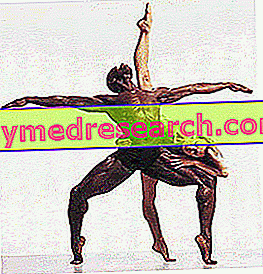By Dr. Luca Franzon
POSTURE ....
"Make sure the foundations are well leveled and everything will be fine" AT STILL

Sir Charles Scott Sherrington in his "Integrated Action of the Nervous System" wrote: "Most of the reflex actions expressed by skeletal muscles are postural." The skeletal system of the human body is maintained in certain postural attitudes in relation to the horizontality of the gaze, to the vertical axis; these attitudes are one in relation to the other.
Charles Bell in 1837 asked himself: "How does a man maintain a straight or inclined posture against the wind blowing against him? It is evident that he has a sense through which he knows the inclination of his body and that he possesses the capacity to readjust and correct all waste in relation to the vertical ".
It must then to
- ROMBERG the role of vision and podal proprioception.
- FLOURENS the role of the vestibule.
- LONGET the role of the proprioception of the paravertebral muscles
- DE CYON the role of oculo-motive proprioception
- MAGNUS the role of the sole of the foot. isi of many variables.
Jungmann, McClure and Backaches in 1963 in "postural decline, aging and gravity-strain" wrote "If we consider posture as the result of the dynamic interaction between two groups of forces (the environmental force of gravity on the one hand and the strength of the individual from the other), then posture is nothing other than the form in which the balance of power that exists at any time between these two groups of forces is expressed.Therefore, any deterioration of posture indicates that the individual is losing ground in its struggle with the environmental force of gravity ".
The term "posture" comes from the Latin "positura" which means position, a term derived in turn from pònere. By posture we therefore mean the relationship with which the different body segments contribute to the implementation of any gesture or position
Posture is influenced by various factors that various parts of our body perceive and transmit to the nervous system, which in turn processes a series of responses. All this can be called postural system. It appears as a very complex whole, formed by various structures of the central and peripheral nervous system, among which:
- the eye
- the foot
- the skin system
- the muscles
- the joints
- the stomatognathic system (occlusal system and tongue)
- the inner ear
In assessing the degree of adaptation of the various subsystems of the posture, clinical tests, instrumental examinations, as well as the anamnesis and observation of the subject are used. The individual will be analyzed in an orthostatic position (in feet), in the three planes of space (frontal, sagittal and transverse) and can be positioned behind a posturoscope, an instrument made in a grid of the size of a man on which the vertical of Barrè will be drawn or sagittal line. In the anterior posterior region, in the absence of the posturoscope, the plumb line is used which coincides with the central line of gravity passing through:
- the center of gravity of the head which is located at the level of the posterior clinoid apophyses of the turcic saddle of the sphenoid
- forward to the odontoid apophysis
- the vertebral bodies of C3, C4, C5
- the sacral promontory
- the half of the coxo-femoral joint
- half of the knee
- the scaphoidal astragal joint.
This gravity line, when the subject is examined in profile, materializes with the following landmarks:
- the tragus of the ear
- the acromioclavicular joint
- the great trochanter
- half of the external condyle of the tibia
- the ankle in front of the external malleolus.
Besides the vertical of Barrè during the postural evaluation of the subject one observes and evaluates whether several points are in equilibrium and symmetry. Previously we will have as a reference point:
- the bipupillary line
- the biacromial line
- the intermammary line
- the line of the anterior superior iliac spines
- the line of the wrists.
Also anteriorly it will be evaluated if the chin, the xiphoid apophysis of the sternum and the navel are positioned on the same line. A further point of evaluation will be the so-called triangle of the size formed by the line of the side with the arm. Usually those who have scoliosis have one shorter than the other.
Later on you will have as a reference point:
- the biacromial line
- the line of the shoulder blades
- the bis iliac line
- the gluteal line
- the line of the folds of the knees
Also posteriorly it will be evaluated if the seventh cervical vertebra and the medial crest of the sacrum are positioned on the same line.
From the observation, any changes in position with respect to an ideal model can be detected. Moreover, asymmetries and rotations of the skeletal segments will be evaluated as well as the presence of areas of altered trophism and / or muscle tone
Parallel to the evaluation of the Barrè vertical, the various subsystems (eye, feet and the ones listed previously) must be studied to understand which of them are in dysfunction, therefore triggering cause of postural problems. Instead, leaving the appropriate figures to evaluate the eyes and ears, the functionality of the foot must be evaluated. The latter must be evaluated both in static and in dynamic conditions to ascertain the presence of paramorphisms such as flatness, cavism or excesses of pronation and supination
In the 1970s, Professor Martins da Cuhna, a physician in Lisbon, described postural deficiency syndrome as a set of signs and symptoms that constitute a dysfunctional state of the subject.
The various symptoms may seem unrelated to each other or unrelated. If instead we consider the postural deficit as a problem of a single system (the postural system), but capable of interacting directly or indirectly on different organs and systems, then it will be simpler and more logical to explain the remarkable apparent diversity of the symptoms.
The symptomatology manifested by the subject often makes the medicine fail to place the patient in a precise category as the symptoms migrate and affect the most varied apparatuses.
Naturally, the instructor must not substitute himself for the doctor, but once the latter has declared the client capable of physical activity, then, after a careful postural evaluation, he can try to resolve the various problems of the client through an activity. physics aimed at solving postural problems.
POSTURAL DEFICIENCY SYNDROME
| ACHE | TURBE BALANCE | OPHTHALMOLOGICAL SIGNS |
headache retro-ocular pain chest or abdominal pain gastralgia rachialgia | nausea daze vertigo unexceptionable falls | astenopia vision move monocular or binocular diplopia directional scotomas bad location of the objects in space |
PROPRIOCEPTIVE SIGNS | ARTICULAR SIGNS | NEURO-MUSCULAR SIGNS |
length discrepancies somatoagnosie errors of appreciation of one's body schema | joint syndrome temporomandibular joint stiff neck lumbago periarthritis distortions | paresthesia motor control defects of the extremities |
NEURO-VASCULAR SIGNS | HEART CARDS | RESPIRATORY SIGNS |
paresthesia of the extremities Raynaud's phenomenon | tachycardia fainting | dyspnoea fatigue |
ENT SIGNATURES | PSYCHIC SIGNS | |
hum deafness foreign body sensation in the glottis dysphonia | dyslexia agoraphobia lack of concentration memory loss asthenia anxiety depression |



